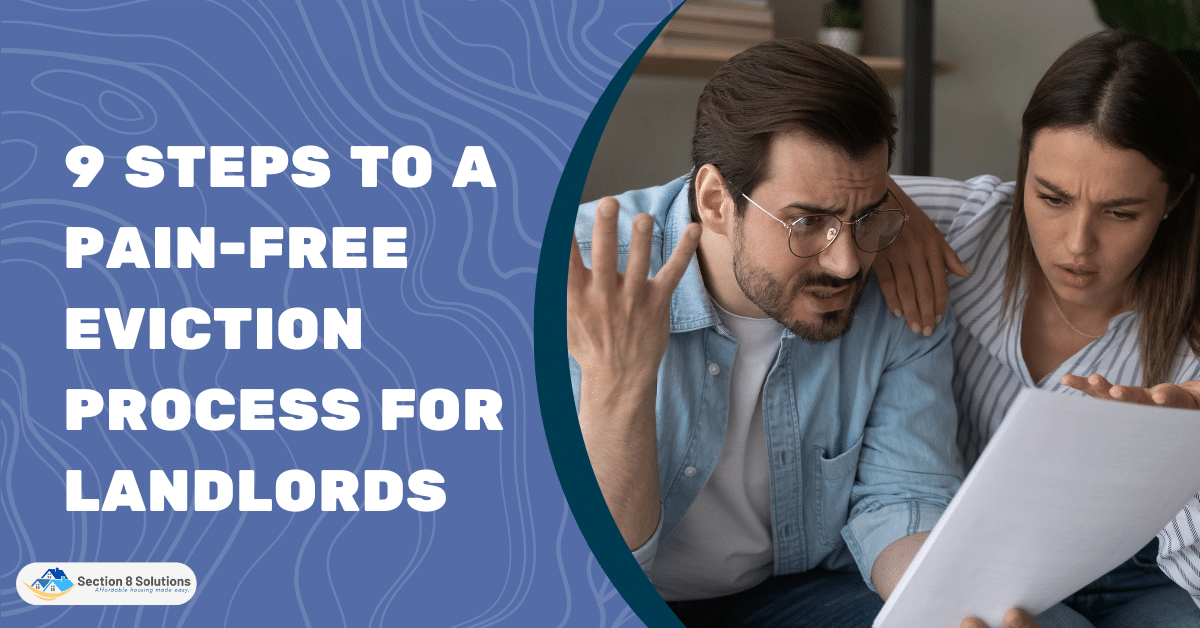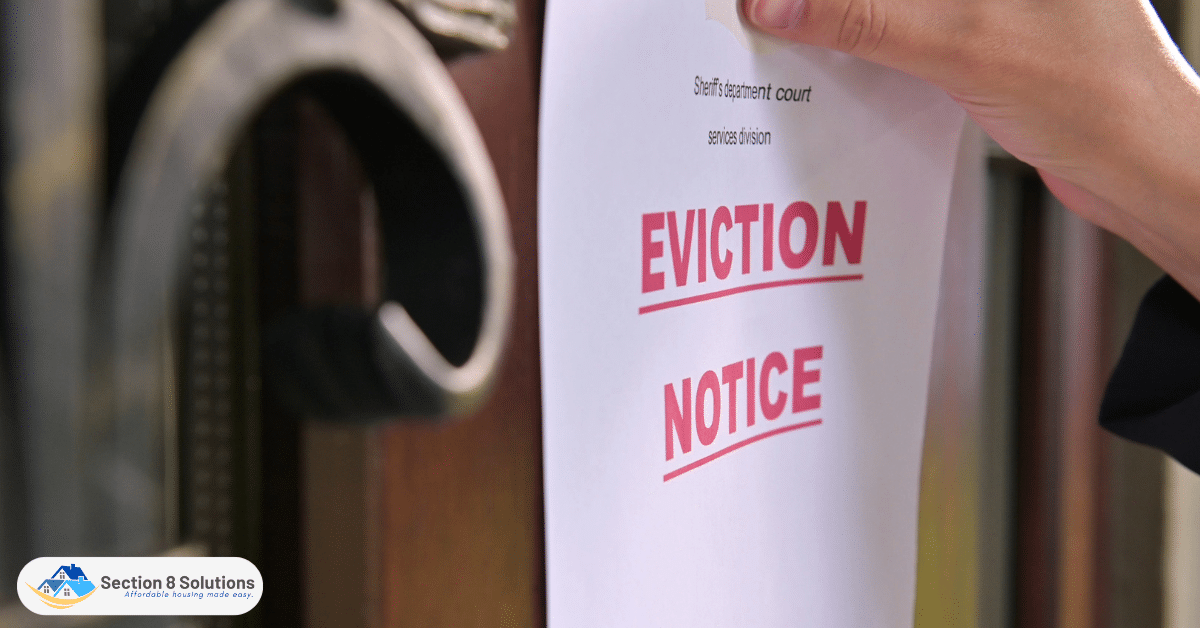As a landlord, the eviction process can be a painful and time-consuming experience. To make it as pain-free as possible, start by establishing clear communication with your tenant and outlining the terms of the lease agreement. To guarantee a smooth and effective eviction, observe your state’s laws and consult a lawyer.
In this article, we’ll discuss nine steps that landlords can take to make the eviction process as smooth and stress-free as possible. These strategies help landlords avoid legal issues, keep tenants happy, and succeed.

1. Establish Clear Communication
Evictions require clear communication between landlords and tenants. Honest communication between landlords and tenants helps avert misunderstandings and legal conflicts.
Starting with a written lease agreement that defines both sides’ rights and duties will help landlords communicate. This covers rent, due dates, late fees, maintenance, and property use restrictions.
In addition, landlords should set expectations from the beginning by clearly communicating their policies regarding rent payments, maintenance requests, and other issues that may arise. This can be done through written notices, emails, or even in-person meetings.
It’s also important for landlords to be responsive to their tenants’ needs and concerns. This means being available to answer questions, addressing maintenance issues promptly, and responding to communication in a timely manner.

2. Understand Your State’s Laws
Understanding the eviction laws in their state is essential for landlords to navigate the eviction process smoothly and legally. Each state has its own set of laws and regulations that govern landlord-tenant relationships, and failure to comply with these laws can result in legal penalties and disputes.
Landlords can learn more about their state’s eviction laws through a variety of resources, such as legal websites, local housing authorities, and state-specific guides and handbooks. These resources can provide information on notice requirements, legal reasons for eviction, and other important details that vary from state to state.
Some of the key laws that landlords should be familiar with include notice requirements, which dictate how much notice must be given before an eviction can take place. For example, some states require a notice of 30 days, while others may require up to 90 days.

3. Attempt to Resolve the Issue Amicably
As a landlord, evicting a tenant can be a costly and time-consuming process. In some cases, it may be possible to resolve the issue amicably and avoid eviction altogether. This can be beneficial for both parties, as it can help maintain a good relationship and avoid legal fees.
One strategy for resolving issues amicably is to offer a payment plan for tenants who are struggling to pay rent. This can involve breaking down the rent into smaller, more manageable payments, or offering a temporary reduction in rent until the tenant is able to catch up. Negotiating a move-out date with the tenant can also be a successful strategy, particularly if the tenant is willing to vacate the property voluntarily.

4. Serve the Proper Notice
When an eviction becomes necessary, it’s crucial for landlords to serve the proper notice to tenants. This is not only required by law but also helps ensure that tenants are aware of the situation and have a clear understanding of their options and responsibilities.
The eviction circumstances determine the notice required. If a renter is late on rent, a notice to pay or quit may be required. A notice to cure or vacate may be required for lease violations. If a landlord does not want to renew a lease, a notice of termination may be needed.
Landlords must follow state and local laws while serving the notice. This may require certified mail or hand-delivering the notification to the tenant. The notification should be precise and simple, stating the purpose of the notice, the deadline for compliance, and any repercussions for non-compliance.

5. File for Eviction with the Court
When all other attempts to resolve issues with tenants have failed, landlords may need to file for eviction with the court. This involves submitting the necessary paperwork and fees to the appropriate court in the jurisdiction where the property is located.
The specific process for filing for eviction will vary depending on the state and local laws in the area. However, in general, landlords will need to provide documentation that supports their case for eviction, such as the lease agreement, notice of non-compliance, and any evidence of the tenant’s failure to comply.
It’s important for landlords to be prepared and organized when filing for eviction with the court. This may involve gathering all necessary documentation, following all deadlines and procedures, and being prepared to appear in court if necessary.
In addition, landlords can benefit from learning more about the eviction process in their state. Resources such as legal websites, local housing authorities, and attorneys can provide valuable information and guidance for navigating the court system and ensuring a smooth and successful eviction process.

6. Attend the Court Hearing
When landlords file for eviction, they will typically need to attend a court hearing. This can be a nerve-wracking experience, but being prepared and knowing what to expect can help make the process smoother.
At the court hearing, landlords will have the opportunity to present their case to a judge. It’s important for landlords to bring all necessary documentation, such as the lease agreement, notice of non-compliance, and any evidence of the tenant’s failure to comply.
Landlords should be prepared to communicate effectively with the judge and the tenant’s legal representation, if applicable. This may involve explaining the situation clearly and succinctly, answering any questions from the judge or the tenant’s representative, and remaining calm and professional throughout the hearing.

7. Enforce the Eviction Order
Once a landlord receives an eviction order from the court, they must take steps to enforce it. This typically involves coordinating with law enforcement to physically remove the tenant from the property.
Before enforcing the eviction order, landlords should communicate with the tenant about their move-out date and ensure that they have a plan in place for removing their belongings. It’s important to enforce the eviction order in a respectful and legal manner, as landlords can face legal repercussions if they engage in unlawful eviction practices.
Landlords may also want to consider hiring a professional eviction company to assist with the physical eviction process. These companies have experience with the eviction process and can help ensure that the eviction is carried out in a legally compliant manner.

8. Document Everything
When going through an eviction process, documentation is crucial. Landlords should keep track of all communication with the tenant, including phone calls, emails, and text messages. They should also keep copies of any notices or letters sent to the tenant, such as a notice to pay rent or quit.
Legal disputes benefit from detailed documentation. If a tenant alleges that they were not given appropriate notice, the landlord can present proof. Documentation can help landlords deal with collections agencies by proving the amount owing and the collection efforts.
Landlords can organize documents in a folder or software tool. For simple retrieval, they should date and label each document. Landlords should also follow data privacy rules and securely keep and dispose of sensitive documents.

9. Follow-Up After the Eviction
After the eviction process is complete, it’s important for landlords to follow up with the tenant to ensure that the property has been fully vacated and any necessary repairs have been made. This can help prevent any potential legal issues or disputes in the future. Landlords should also document the condition of the property after the tenant has left, taking photos if necessary.
Landlords should also assess the eviction procedure for improvements. This can avoid future evictions or make them easier. Landlords should review the eviction procedure and consider whether they made any mistakes. To get a new perspective, they should ask lawyers or other landlords.

Conclusion
Evicting a tenant is stressful for landlords. However, by following these nine procedures, landlords may make the eviction process as painless as possible. Communicate with tenants, try to settle concerns amicably, serve the correct notice, file for eviction with the court, attend the court hearing, execute the eviction order, document everything, and follow up after the eviction.
Landlords must remain calm and follow the law to succeed. Thus, landlords may safeguard their property rights and avoid legal issues. A smooth eviction process helps landlords and tenants move on with minimal stress and interruption.












